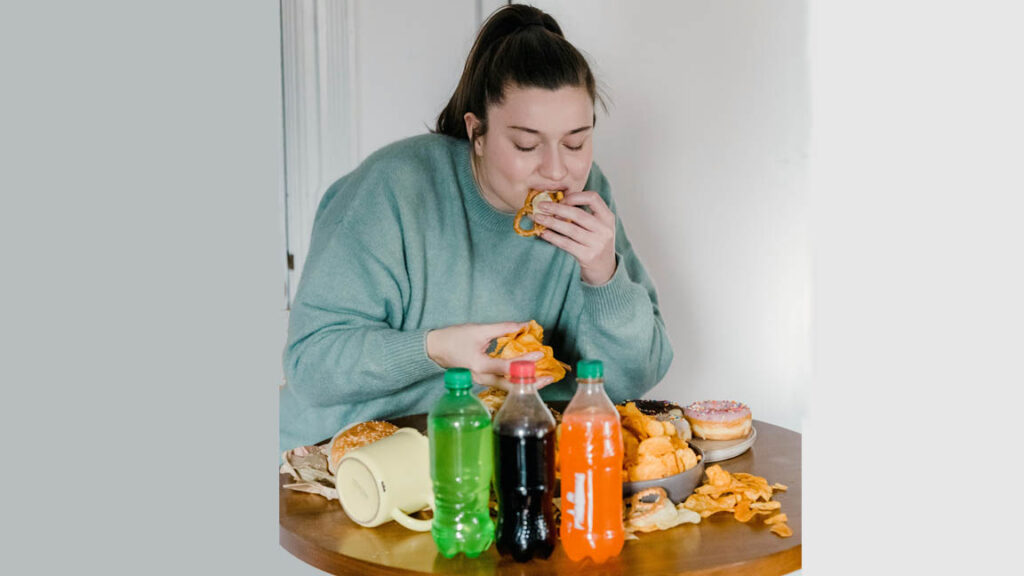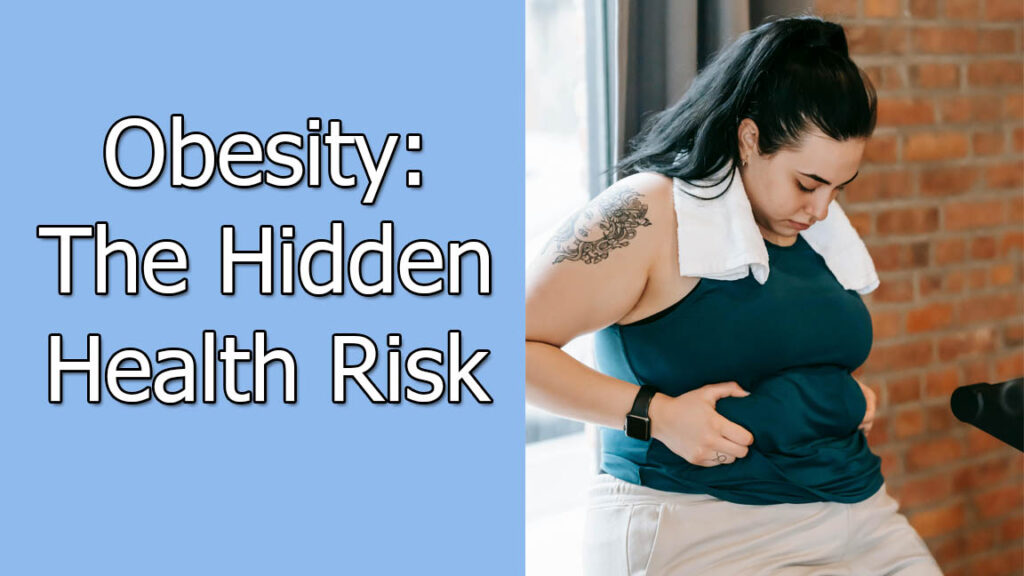Motapa (Obesity) sirf scale par numbers ka khel nahi hai.
Yeh aapke sharir ke lagbhag har system par ek roz ka silent stress test hai — dil aur blood vessels se lekar liver aur pancreas tak, brain aur hormones se lekar neend aur mood tak.
Nuksaan khamoshi se shuru hota hai — inflammation, hormonal imbalance aur cells ke dheere-dheere ghisne (wear-and-tear) ke zariye. Aur ek din yeh khamoshi tod kar saamne aa jaata hai, jab problem clearly dikhne lagti hai.
Neeche diya gaya guide ek gaharaai se research kiya gaya aur practical analysis hai, jo batata hai ki Motapa (Obesity) sharir ko kaise chhupkar nuksaan pahunchata hai. Iske liye evidence liya gaya hai World Health Organization (WHO), The Lancet, Harvard T.H. Chan School of Public Health, IARC/WHO (cancer arm), American Academy of Sleep Medicine, aur bade peer-reviewed journals jaise BMJ, Gastroenterology se.
Why Obesity Quietly Hurts Cells and Organs Every Day 🧬
Motapa (Obesity) sirf weight ka number nahi hai — yeh ek daily silent attack hai jo cells aur organs ko dheere-dheere damage karta hai. Har din, bina awaaz ke, obesity ke effects andar hi andar ek “slow fire” ki tarah jalte rehte hain.
Chronic Low-Grade Inflammation 🔥
Excess fat tissue — specially belly fat — ek endocrine organ ki tarah kaam karta hai. Yeh continuously inflammatory molecules (adipokines aur cytokines) release karta hai. Yehi “background inflammation”:
- arteries me plaque banata hai (atherosclerosis accelerate karta hai),
- insulin resistance ko aur badhata hai,
- hormones disrupt karta hai,
- aur mitochondria (jo har cell ki powerhouse hai) ko stress deta hai.
Cardio-metabolic research clearly batati hai ki yehi inflammatory pathways heart disease ka strong risk factor hain.
Insulin Resistance & Mitochondrial Stress ⚡
Harvard T.H. Chan School of Public Health (May 28, 2025) ki fresh study ne dikhaya ki obesity directly mitochondrial function impair karti hai (specially muscle aur liver me).
Result? Cells energy process karne me kamzor ho jaate hain → insulin resistance aur phir type 2 diabetes ka seedha raasta.
Ultra-Processed Foods (UPFs) = Hidden Fuel
BMJ (2024) ki large studies confirm karti hain ki high UPF intake = high risk of:
- cardiometabolic disease
- depression
- early death
Kyun? Kyunki UPFs:
- calorie-dense hote hain,
- fiber/micronutrients kam hote hain,
- over-consumption ke liye design kiye gaye hote hain (shelf life + hyper-palatability).
Yeh food environment obesity ko aur zyada engineered karta hai.
Liver Overload: New Naming, Same Damage
Jo pehle NAFLD (non-alcoholic fatty liver disease) ke naam se jaana jaata tha, use 2023–2024 me rename karke MASLD/MASH (metabolic dysfunction–associated liver disease) kar diya gaya.
Naam change ka maksad clear hai: real root = metabolic dysfunction, aur obesity iska biggest driver hai.
Sleep & Weight: The Two-Way Trap 😴
Obesity → sleep apnea (OSA) ko badhata hai.
Aur sleep apnea → hormones disturb karke aur weight gain trigger karta hai.
American Academy of Sleep Medicine baar-baar isko highlight kar chuki hai — ek vicious cycle jisme se nikalna tough hota hai.
The Global Picture You Can’t Ignore
1990–2022 ke beech:
- Adults me obesity double ho gayi.
- Children & adolescents (5–19 yrs) me obesity quadruple ho gayi (2% → 8%).
- 2024 me hi, 35 million children under 5 overweight the — jisme half se zyada Asia me.
The Lancet (2024) ke global data ne yeh confirm kiya: jahaan underweight kam hua, wahi obesity ne health landscape ko badal diya — across men and women.
Yeh sirf statistics nahi, balki kal ka disease burden ka preview hai.
Your Heart & Blood Vessels: Daily Silent Strain ❤️
Har din, extra body mass aur inflammation ki wajah se:
- heart ko zyada pressure pump karna padta hai,
- vessels ke endothelial cells damage hote hain,
- arteries stiff ho jaati hain,
- aur plaque build-up fast hota hai.
Yeh hi raasta hai hypertension, coronary artery disease, atrial fibrillation, aur stroke tak.
Aur jab aapki diet me UPFs + sedentary lifestyle + short sleep add ho jaata hai → cardiovascular daily wear and tear aur accelerate ho jaata hai.
Takeaway: Even without diagnosis, obesity har din aapka blood pressure, lipids, aur vessel inflammation quietly badha raha hota hai.
The Pancreas & Blood Sugar: Diabetes ki Dheemi Raftaar 🍬
Insulin aapke blood sugar ka “key” hai. Lekin jab weight continuously badhta hai, to cells insulin ke signals ko ignore karne lagte hain. Result: pancreas ko aur zyada insulin banana padta hai. Dheere-dheere yeh beta cells thak jaate hain.
Harvard T.H. Chan School of Public Health (2025) ki latest research ne dikhaya hai ki obesity mitochondria (cells ki energy factories) ko damage karta hai → jisse insulin resistance aur type 2 diabetes ka risk aur pakka ho jaata hai. Yaani problem sirf calories ki nahi, balki cellular energy failure + inflammation ki hai.
Daily warning signs hamesha saamne hote hain:
- fasting glucose badhna,
- triglycerides high rehna,
- aur waist circumference dheere-dheere badhna.
Ye “trio” diabetes aane se pehle metabolic strain dikhata hai.
The Liver: Fat Build-Up → Inflammation → Scarring (MASLD/MASH) 🩸
Liver aapke blood ko filter karta hai aur nutrients process karta hai. Lekin motape me liver cells me fat jama hone lagta hai → isse MASLD (Metabolic dysfunction–associated steatotic liver disease) hota hai.
Kuch cases me yeh aage badhkar MASH ban jaata hai (jisme inflammation + injury hoti hai), aur phir fibrosis, cirrhosis, hatta ki liver cancer tak.
NAFLD ko 2023–2024 me rename karke MASLD/MASH rakhne ka reason yahi tha: root cause hai obesity-driven metabolic dysfunction.
Achhi baat? Agar weight loss 7–10% bhi ho jaye, to liver fat aur inflammation improve ho sakta hai. Lekin jitna lamba exposure, utni reversal mushkil.
The Brain: Memory, Mood & Cognition
Midlife me obesity hone ka matlab hai future me dementia aur cognitive decline ka bada risk.
2020 ke ek systematic review + meta-analysis ne dikhaya ki midlife obesity se dementia risk ~31% zyada hota hai. Risk aur increase hota hai jaise hi BMI 30–32 se upar jaata hai.
Kyun hota hai aisa?
- vascular damage,
- brain me insulin resistance,
- aur chronic inflammation.
Mood bhi impact hota hai: high UPF (ultra-processed food) intake ko depression aur anxiety se link kiya gaya hai. Clearly, metabolic health aur mental health deeply interconnected hain — sleep, gut-brain axis, hormones, sab role play karte hain.

Cancer: Jitna Log Sochte Usse Zyada Risk 🎗️
Obesity sirf diabetes aur heart ka risk nahi badhata, balki multiple cancers se bhi linked hai.
IARC/WHO ke evidence ke hisaab se body fatness se risk badhta hai:
- breast cancer (postmenopausal),
- colon, liver, pancreas, kidney,
- endometrium, ovary aur aur bhi.
Mechanisms me include hote hain:
- insulin aur IGF-1 signaling,
- inflammation,
- sex hormones,
- aur adipokines.
Daily exposure to chronic inflammation + hormonal imbalance dheere-dheere cancer ka risk build karta hai.
Good news? Even modest weight loss time ke saath cancer-prevention me disproportionate benefits de sakta hai.
Lungs & Sleep: Jab Saans Hi Pressure Me Ho 😴
Extra fat around neck, tongue, aur airway → breathing narrow ho jaata hai → obstructive sleep apnea (OSA) develop hota hai.
Isme raat bhar breathing ruk-ruk kar chalti hai, oxygen level girta hai, aur heart aur vessels par stress padta hai.
Aur yeh 2-way relation hai:
- obesity OSA ko worse karta hai,
- untreated OSA aur weight gain + metabolic dysfunction ko trigger karta hai (appetite hormones like ghrelin/leptin disturb ho jaate hain).
Isi liye doctors recommend karte hain ki agar kisi ko obesity + loud snoring + resistant hypertension hai, to OSA screen zaroor karna chahiye.
Joints, Muscles & Mobility: More Load, Less Repair
Zyada body weight = zyada pressure on knees, hips, spine aur chhoti joints tak.
Fat tissue ki inflammation cartilage ko degrade karti hai. Dheere-dheere osteoarthritis ka risk badhta hai. Movement painful hone lagta hai → activity kam hoti hai → aur weight gain hota hai. Ek dangerous vicious cycle.
Hormones & Fertility: Quiet Disruptions, Big Consequences
Adipose tissue sirf fat store nahi karta, balki hormones produce aur convert karta hai.
Zyada fat mass → sex hormone imbalance:
- Women me: menstrual cycle irregular, PCOS risk high, ovulation aur fertility impact.
- Men me: testosterone low, sperm quality poor.
Yeh changes chhupke-chhupke saalon tak accumulate hote rehte hain — tab tak jab tak fertility care ki zarurat nahi pad jaati.
🌿 Pet aur Food Environment: Sirf “Willpower” ka mamla nahi
Aaj ka modern food environment — jahan har taraf cheap, easily available, aur ultra-processed foods (UPFs) chhaye huye hain — hamare daily choices ko dheere-dheere calorie-dense aur nutrient-poor patterns ki taraf dhakel dete hain. Research studies ke pooled analysis ye dikhate hain ki UPF intake zyada hone par Motapa (Obesity) aur kai serious health risks ka chance barh jata hai.
Yeh koi “moral failing” nahi hai, balki biology aur environment ka dangerous combination hai.
Wapas sehat ki taraf aane ka raasta hai — apni lifestyle ko is tarah design karna jahan aap whole foods, fiber-rich khana, protein anchors, aur slow eating ko default bana paayein.
Bachche aur Naujawan: Childhood ka weight kyu matter karta hai adult health ke liye
Agar bachpan me excess weight ya Motapa (Obesity) ho, to wo seedha adulthood tak track karta hai, aur lifetime risk badha deta hai — diabetes, heart disease, sleep apnea, aur kuch cancers tak.
U.S. CDC ke 2024 update ke hisaab se, 2 se 19 saal ke bachcho me lagbhag 19.7% bachche Motapa (Obesity) se joojh rahe hain.
Globally, WHO ne report kiya hai ki millions of children under 5 years overweight ya obese hain — sabse fast growth unhi regions me ho rahi hai jahan kabhi undernutrition ek badi problem thi.
Solution? Family aur schools level par prevention — jaise ki better sleep routines, active play, aur UPFs kam karna — jo bachpan se adulthood tak ek healthy track bana dete hain.
5 “Hidden” Roz ke Nuksan jo aap already mehsoos kar rahe ho (lekin connect nahi kiya)
- Subah uthte hi thakan — chahe aapko lagta ho ki “sleep enough” hai → ye OSA (Obstructive Sleep Apnea) ya poor sleep quality ka sign ho sakta hai. Thoda sa weight loss bhi help karta hai.
- Lagataar heartburn → pet ki charbi (abdominal fat) reflux pressure ko badhati hai; weight loss + meal timing adjustment relief deta hai.
- Khana khane ke baad brain fog → glucose/insulin spikes aur poor sleep ki wajah se hota hai. Agar aap steady meals (protein + fiber) khayen to “post-lunch crash” kam hota hai.
- Seedhiyan chadte waqt ghutno me dard → inflammatory load + mechanical stress dono ka effect. Low-impact training (jaise swimming, cycling, yoga) se tolerance wapas build hota hai.
- Periods irregular hona ya fertility delay → body me adiposity-driven hormonal shifts ki wajah se. Bas 5–10% weight loss se kai women me ovulation normal ho jata hai.
Research-Backed Habits Jo Aap Aaj Se Shuru Kar Sakte Ho
1) Perfection nahi, pehle 5–10% weight loss ka aim rakho:
Sirf 5–10% Motapa (Obesity) kam karne se hi liver fat ghatta hai, insulin resistance improve hota hai, blood pressure neeche aata hai, aur inflammation calm hota hai. Ye chhoti si shuruaat, badi bimaariyon ke khatre ko kam kar deti hai. (MASLD/MASH aur cardiometabolic trials isko support karte hain.)
2) UPFs ko kam convenient banao, whole foods ko default:
BMJ ke studies ke hisaab se Ultra-Processed Foods (UPFs) ko “sometimes” wali category treat karo. Har meal ka base banao: protein (jo satiety deta hai), fiber (jo sugar levels smooth rakhta hai), aur water-rich plants.
3) Roz move karo, lekin joints ko bachao:
Low-impact exercises jaise walking, cycling, swimming, rowing ko priority do. Saath me strength training add karo — ye insulin sensitivity ko improve karta hai aur “metabolic allowance” badhata hai, bina knees ko overload kiye.
4) Sleep ko priority do (7–9 hours):
Agar snoring ya daytime sleepiness hai to OSA (Obstructive Sleep Apnea) ke liye screen karao. Treatment se blood pressure control hota hai aur weight loss zyada sustainable ho jata hai.
5) Apna environment design karo:
Chhoti-chhoti cheezein bada fark laati hain: smaller plates, visible fruits/veggies, pre-portioned nuts/yogurt, aur snacks ko “out of sight” rakhna. Yeh silent strategies bina extra willpower ke calories cut karti hain.
6) Track karo jo matter karta hai:
Waist circumference, morning weight trends, steps, aur resistance sessions weekly check karo. Ye aapko progress ka signal denge, obsession ka stress nahi.
7) Medical therapy aur clinical care:
Har kisi ke liye nahi, lekin kuch logon ke liye anti-obesity medications aur bariatric surgery sabse effective option hote hain. Jab MASLD/MASH, diabetes ya severe OSA ho, to clinical care + behavior change ka combo sabse durable results deta hai. (Apne doctor se consult karna zaroori hai, kyunki guidelines region ke hisaab se update hoti rehti hain.)
🌱 Din-Ba-Din Reversal: Jab Weight Neeche Aane Lagta Hai, Body Kaise Heal Karti Hai
- Heart & Vessels: Blood pressure neeche, arteries soft, lipid profile zyada protective.
- Pancreas: Insulin sensitivity improve hoti hai, glucose spikes control hote hain, beta-cell ka stress kam.
- Liver: Fat deposit ghatta hai, inflammation calm hota hai, fibrosis ka progression slow ho jata hai.
- Brain: Sleep better, mood steady, dementia risk kam hota hai.
- Cancer Risk: Hormonal aur inflammatory drivers reduce, long-term risk neeche aata hai.
- Sleep: OSA ki severity kam hoti hai, energy aur appetite hormones balance hote hain.
❓ Frequently Asked Questions (Evidence-Based)
Q1) Kya Motapa (Obesity) hamesha personal choice hota hai?
Nahi. Biology, environment, medicines, sleep, stress aur socioeconomic context sab weight ko shape karte hain. WHO aur Lancet ke data dikhate hain ki population-level shifts (jaise UPFs, sleep loss, sedentary work) directly obesity rise se linked hain. Personal action matter karta hai, lekin environment equally powerful hai.
Q2) Agar mai “metabolically healthy but obese” hoon, to safe hoon kya?
Filhaal aapke tests normal ho sakte hain, lekin risk dheere-dheere accumulate hota hai. Chronic inflammation aur organ strain tests abnormal hone se pehle shuru ho jata hai. Gradual weight loss aur regular monitoring phir bhi protection dete hain.
Q3) Kya UPFs itne dangerous hain?
Ji haan. Large analyses me dikhaya gaya hai ki high UPF intake se cardiometabolic aur mental health risk barhta hai. Minimally processed foods lene se satiety aur nutrition dono improve hote hain, bina calories micromanage kiye.
Q4) Fatty Liver (MASLD/MASH) ke liye kitna weight loss help karta hai?
Sirf 7–10% weight loss se liver fat aur inflammation dono ghat jaate hain. Agar fibrosis present hai to aur zyada weight loss helpful hota hai. Early action sabse zyada effective hai.
Q5) Kya Motapa (Obesity) cancer risk ko barhata hai? Kaunse cancers?
Haan. IARC/WHO ke hisaab se Motapa se risk barhta hai: postmenopausal breast, colon, liver, pancreas, kidney, endometrium, ovary aur aur bhi. Mechanisms: insulin/IGF-1, sex hormones aur chronic inflammation.
Q6) Bachcho ka early weight adult risk ko affect karta hai kya?
Bilkul. Childhood obesity directly adulthood obesity aur lifetime risk (diabetes, heart disease, sleep apnea, cancers) se linked hai. U.S. aur WHO ke data dono rising trend dikhate hain. Early habits — sleep, movement, food quality — decades tak health protect karte hain.

Simple Daily Health Template for Better Weight & Energy
1. Breakfast — Protein + Fiber se Shuruaat
🎯 Goal: Lambi der tak pet bhara rahe, blood sugar stable ho, morning energy crash na ho.
🍳 Protein Source:
- Eggs (boiled, scrambled, omelette)
- Greek yogurt (unsweetened)
- Paneer cubes
🥭 Fiber + Slow Carbs:
- Fresh fruit (apple, berries, papaya, banana in moderation)
- Oats (steel-cut ya rolled)
- Whole-grain toast / multigrain roti
👉 Why: High-protein breakfast hunger hormones ko control karta hai aur metabolism ko kick-start deta hai.
2. Lunch — Color + Lean Protein
🎯 Goal: Steady energy, muscles ko support, aur antioxidants for long-term health.
🥘 Protein Options:
- Dal / lentil soup
- Chickpeas, kidney beans, sprouted moong
- Grilled chicken / baked fish
🥗 Veggie Load (Color = Nutrients):
- Big salad (tomato, cucumber, carrot, leafy greens)
- Steamed ya lightly sautéed veggies (broccoli, beans, capsicum, spinach)
🌾 Whole-Grain Carbs:
- Brown rice, quinoa, ya whole-wheat roti
👉 Why: Balanced lunch se afternoon sugar cravings control hoti hain aur metabolism active rehta hai.
3. Snack — Planned, Not Grazed
🎯 Goal: Random khane ki aadat avoid karna jo overeating laati hai.
🥜 Healthy Snack Ideas:
- Handful of nuts (almonds, walnuts, pistachios)
- Fresh fruit + yogurt
- Paneer cubes (black salt + pepper)
👉 Why: Yeh blood sugar stable rakhta hai aur “evening binge” habit ko todta hai.
4. Dinner — Lighter & Earlier
🎯 Goal: Digestion easy ho, sleep improve ho, aur late-night fat storage avoid ho.
🍲 Protein:
- Masoor dal, moong dal
- Fish (grilled, baked, steamed)
- Lean chicken breast
🥦 Vegetables:
- 2 types (1 leafy + 1 starchy/non-starchy)
🌾 Small Whole-Grain Portion:
- 1 small roti ya ½ cup brown rice
⏰ Timing: Dinner bedtime se 2–3 ghante pehle finish karein.
👉 Why: Jaldi dinner digestion ko smooth banata hai, acid reflux aur poor sleep risk ghatata hai.
5. Movement — Rozana Body Active Rakho
🎯 Goal: Calories burn karna, heart health improve karna, muscle maintain karna.
🚶 Daily Target:
- 30–45 mins low-impact activity (brisk walk, cycling, swimming)
🏋️ Strength Training:
- 2–3 short sessions weekly (squats, push-ups, resistance bands)
👉 Why: Strength training muscle preserve karta hai jab fat loss hota hai — aur ye metabolism ke liye crucial hai.
6. Sleep — The Silent Fat-Burner
🎯 Goal: Recovery improve karna, hunger hormones balance karna, stress eating control karna.
😴 Daily Target: 7–9 hours quality sleep
🩺 Tip: Agar snoring ya morning fatigue hai → Sleep Apnea (OSA) ke liye screen karao.
🛏️ Better Sleep Tips:
- Bedtime aur wake time consistent rakho
- Heavy meals & screens bedtime se avoid karo
👉 Why: Poor sleep cortisol (stress hormone) ko high karta hai → belly fat store hota hai.
💬 Final Thought
Motapa (Obesity) ek din me health destroy nahi karta — ye dheere-dheere, har din chhupke damage karta hai.
Lekin wahi slow process body ko heal bhi kar sakta hai — agar aap abhi action lo.
Chhoti, consistent changes in food, movement, sleep, aur stress → years of damage reverse kar sakti hain.
👉 Your body is already working 24/7 for you. Start working with it, not against it.
Start today. Your future self will thank you. 💚
🚨 Aapki Kitchen Chhupa Rahi Hai Ek Silent Killer!
😱 Sugar — har bite dheere-dheere zeher ki tarah kaam kar raha hai.
🍞 Maida — aapke andar se health ko kha raha hai, aur aapko pata bhi nahi.
💡 Truth You Must Read Now:
🔗 Sugar: The Daily Poison Hiding in Your Food
🔗 Maida: Eating You From the Inside — Health Risks
📌 Follow E-Vichar for More Life-Saving Insights:
👉 facebook.com/people/E-Vichar/61577438743345/
⚠️ Don’t just scroll — share this now. You might save someone’s life ❤️




